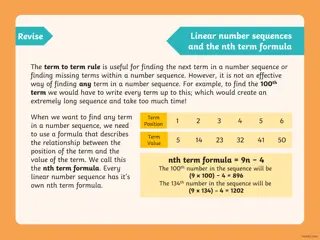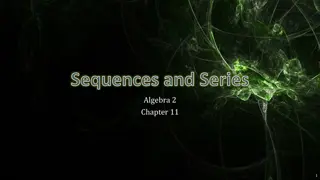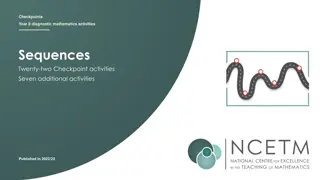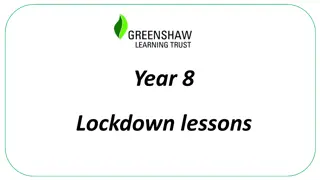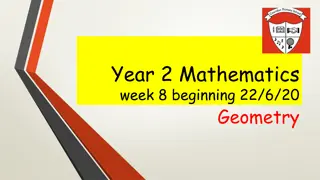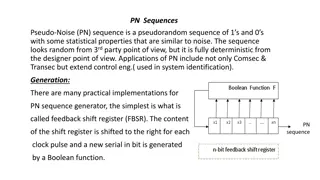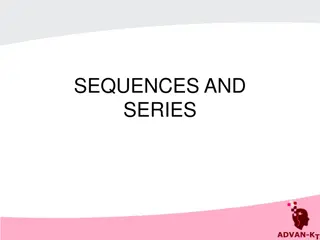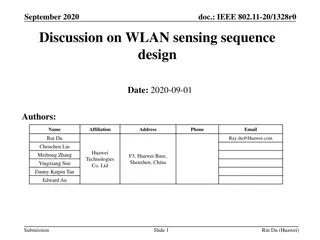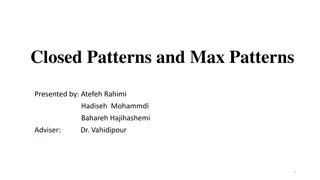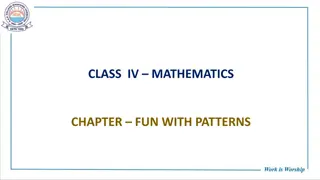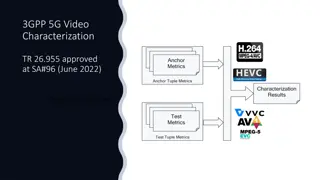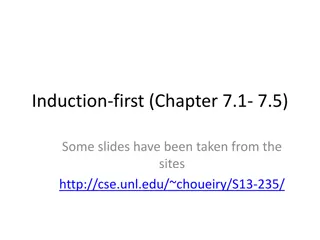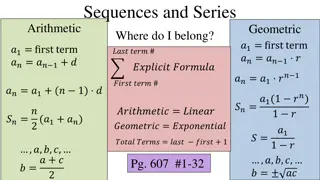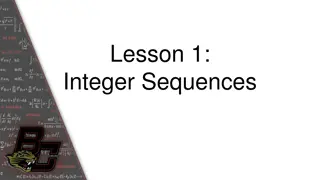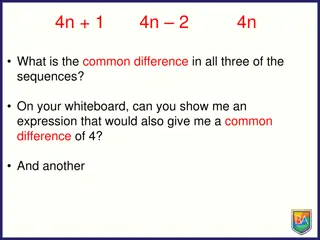Sequences and Patterns in Mathematics
Dive into the world of sequences and patterns with examples and exercises involving identifying patterns, writing formulas, and graphing terms on coordinate planes. Explore different scenarios and learn to express nth terms in sequences. Understand the importance of indexing terms and using proper formulas in mathematical sequences.
Download Presentation

Please find below an Image/Link to download the presentation.
The content on the website is provided AS IS for your information and personal use only. It may not be sold, licensed, or shared on other websites without obtaining consent from the author. Download presentation by click this link. If you encounter any issues during the download, it is possible that the publisher has removed the file from their server.
E N D
Presentation Transcript
LESSON 1 Warm Up, example, notes, example, classwork
Warm Up Mrs. Rosenblatt gave her students what she thought was a simple task: What is the next number in the sequence 2, 4, 6, 8, ? Cody: I am thinking of a plus 2 pattern, so it continues 10, 12, 14, 16, . Ali: I am thinking of a repeating pattern, so it continues 2, 4, 6, 8, 2, 4, 6, 8, Suri: I am thinking of the units digits in the multiples of two, so it continues 2, 4, 6, 8, 0, 2, 4, 6, 8, . 1) Are each of these valid responses? 2) What is the 100thnumber in the sequence for each person s scenario? 3) What is an expression, in terms of n, for the nthnumber in the sequence in Cody s scenario?
Example 1 Jerry has thought of a pattern that shows powers of two. Here are the first six numbers of Jerry s sequence: 1, 2, 4, 8, 16, 32, . Write an expression for the nthnumber of Jerry s sequence. Key Point: Should you start with n=0 or n=1? In the big picture it doesn t matter as long as you define your starting point, but for this module we will assume starting with n=1 to keep everyone consistent.
Example 1, continued Key Point: Should you start with n=0 or n=1? In the big picture it doesn t matter as long as you define your starting point, but for this module we will assume starting with n=1 to keep everyone consistent.
Notes A sequence can be thought of as an ordered list of elements. Each element is called a term. Terms are usually indexed using subscripts, and for this module we will start with 1: a1, a2, a3, The ellipsis ( ) indicates a regular pattern. The terms are spoken as a sub 1, a sub 2 etc. When using a formula you can also use f(n) notation, which is spoken as f of n, f of 1, f of 2 etc. meaning formula for the nth term or formula for the 2nd term. Graphs will be discrete points, not continuous.
Example 2 Consider the sequence: 4, 7, 10, 13, 16, . 1) Write a formula for the sequence using both the an notation and the f(n) notation. 2) Does the formula f(n) = 3(n - 1) + 4 generate the same sequence? Why might some people prefer this formula? 3) Graph the terms of the sequence as ordered pairs n, f(n) on a coordinate plane. What do you notice about the graph?
Example 2, continued Consider the sequence: 4, 7, 10, 13, 16, . 3) Graph the terms of the sequence as ordered pairs n, f(n) on a coordinate plane. What do you notice about the graph?
Workshop Must Do May Do Classwork1 #1 - 3 Reflection questions Khan Academy Classwork1 #4 Carnival Bears/Crossing the River Exponents review Linear equation practice
Reflection Questions Why is it important to have a formula to represent a sequence? It is important to have a formula to represent a sequence to demonstrate the specific pattern and to help in finding any term of the sequence (20th term, 50th term, 1,000th term, and so on). This is very useful when we need to make predictions based on the formula chosen to model the existing data sequence. Can one sequence have two different formulas? Yes, depending on what value of n you chose to start with. Some students may point out that two different-looking formulas may be related by equivalent expressions: 5(n+2) is different from 5n+10. What does f(n) represent? How is it read aloud? It represents the nth term of a sequence just like an. It is read f of n.
LESSON 2 Warm Up, Example, Notes
Warm Up/Recall RECURSIVESEQUENCE: A recursive sequence is a sequence that is defined by (1) giving an initial term and (2) building off that term with a set rule. We saw these in Module 1 when you explore the double and add 5 game. Find the first 5 terms of these recursive sequences: a1= 3 and ai+1=ai + 3, for i 1, a1 = 3 and ai+1 = 3ai, for i 1,
Example 1 Consider Akelia s sequence 5, 8, 11, 14, 17, . If you believed the pattern, what might you say is the next number? When asked to write a formula for her sequence, Akelia started by writing: 5 8 = 5 + 3 11 = 5 + 3 + 3 = 5 + 2 3 14 = 5 + 3 + 3 + 3 = 5 + 3 3 Use this reasoning to help write her formula, using the letter A to name it, for Akelia s sequence.
Example 1, continued Akelia s sequence 5, 8, 11, 14, 17, . Formula: A(n) = 5 + 3(n - 1) What does A(n) mean again? Explain how each part of the formula relates to the sequence What s another, equivalent, way to write this formula?
Example 1, continued Akelia s sequence 5, 8, 11, 14, 17, . When Johnny saw the sequence he wrote the following: A(n+1) = A(n) + 3 for n 1 and A(1) = 5 What does A(n+1) mean? 5 8 = 5+3 11 = 8+3 14 = 11+3 17 = 14+3 What do we call the 5th term? How do you find the 5th term in terms of the 4th term? How do you find the 6th term in terms of the 5th term? How do find the (n+1)th term in terms of the nth term?
Notes RECURSIVESEQUENCE: A recursive sequence is a sequence that is defined by (1) giving an initial term and (2) building off that term with a set rule. Explicit Formula: specifies the nth term of a sequence as an expression. Used to find any term without know preceding one. Example: A(n) = 5 + 3(n - 1) Recursive Formula: specifies the nth term of a sequence based on the preceding term(s). Example: A(n+1) = A(n) + 3 Note on notation: Subscripts and parentheses serve the same purpose in indexing terms in a sequence. Both will be used throughout the unit.
Example 1, continued Akelia sformula was an explicit one. Johnny s was recursive. Why does Akelia sformula has times 3 when Johnny s has plus 3 ? If we wanted the 200th term in the sequence, whose formula would we most likely use? If you wanted to know how the sequence changes from one term to the next, whose formula is more useful? To find the 200thterm using Johnny s formula, what would we need to know?
Example 2 Consider a sequence given by the formula an = an-1 - 5, where a1 = 12 and n 2. List the first five terms of the sequence. Write an explicit formula. Find a6 and a100 of the sequence.
Workshop Must Do May Do Classwork2 #1-6 Summary/Reflection Complete cw #1 Khan Academy Extension assignment Crossing River/Carnival Bears Linear Equation practice/review Exponents
LESSON 3 Warm Up, notes, classwork
Warm Up/example 1 Yesterday, we talked about the sequences created by Akelia. What sequence does ? ? + 1 = ? ? 3 and ?(1) = 5 for ? 1 yield? What sequence does ?(? + 1) = ?(?) + 3 and ?(1) = 5 for ? 1 yield?
Warm Up/example1, continued Johnny suggests that they plot the sequences to help them understand the patterns. What is the slope of the line connecting the points? Is there a relationship between the slope and sequences themselves? Sequences that create linear graphs are called arithmetic.
Example 2 Now look at the sequence 1, 3, 9, 27, . What do you notice? How is the sequence different from the sequences before? If we plot this sequence we get this graph. Is this arithmetic/linear? Sequences that create exponential graphs are called geometric.
Notes There are two primary types of sequences: Arithmetic: sequences that show an addition or subtraction pattern and create linear graphs. y=mx+b f(n) Explicit formula: SLOPE Y-INTERCEPT INITIAL VALUE FIXED AMOUNT (0, b) x=0 CONSTANT RATE RATE OF CHANGE rise run x2- x1 y2- y1 changey changex
Notes There are two primary types of sequences: Geometric: sequences that show a multiplication or division pattern and create exponential graphs. f(n) = a(b)x Explicit formula: INITIAL VALUE GROWTH OR DECAY RATE >1 growth <1 decay
Workshop Must Do May Do Exit ticket 1-3 Classwork 3 #1-2 Reflection/summary question Classwork3 #4-5 KhanAcademy Exponents review Linear practice
LESSON 4 Examples, notes, classwork
Warm Up Have you ever thought it odd that banks pay YOU interest for the honor of looking after your money for you? Throughout history, people had to PAY BANKS to look after their money. In the Renaissance, with the rise of world exploration, banks realized that looking after people s money was an incredibly good thing for them. They could make money off of the large amounts of money they were keeping for others. They wanted to encourage more people to give them their money to keep, so they started paying customers.
Banks originally computed simple interest, and that is the type of interest studied in this example. Simple interest is calculated at the end of each year on the original amount either borrowed or invested (the principal). Kyra has been babysitting since sixth grade. She has saved $1,000 and wants to open an account at the bank so that she earns interest on her savings. Simple Bank pays simple interest at a rate of 10%. How much money will Kyra have after 1 year? After 2 years, if she does not add money to her account? After 5 years?
Example 1 Raoul needs $200 to start a snow cone stand for this hot summer. He borrows the money from a bank that charges 4% simple interest per year. How much will he owe if he waits 1 year to pay back the loan? If he waits 2 years? 3 years? 4 years? 5 years? Write a formula for how much he will owe after ? years.
In the 1600s, banks realized that there was another way to compute interest and make even more money. With compound interest, banks calculate the interest for the first period, add it to the total, and then calculate the interest on the total for the next period, and so on.
Try to write an explicit formula for this. Start with writing the recursive pattern.
Example 2 Jack has $500 to invest. The bank offers an interest rate of 6% compounded annually. How much money will Jack have after 1 year? 2 years? 5 years? 10 years?
Example 3 If you have $200 to invest for 10 years, would you rather invest your money in a bank that pays 7% simple interest or in a bank that pays 5% interest compounded annually? Is there anything you could change in the problem that would make you change your answer?
Notes - Interest SIMPLEINTEREST: Interest is calculated once per year on the original amount borrowed or invested. The interest does not become part of the amount borrowed or owed (the principal). I = prt (calculates interest only) COMPOUNDINTEREST: Interest is calculated once per period on the current amount borrowed or invested. Each period, the interest becomes a part of the principal. FV = p(1+r)t (calculates future total) r is the interest rate written as a decimal, t is time, p is principal amount
Workshop Must Do May Do Complete classworks 1-3 Classwork/homework
LESSON 5 Warm up/example, Classwork, discussion/summary
Warm Up/example Two equipment rental companies have different penalty policies for returning a piece of equipment late. Company 1: On day 1, the penalty is $5. On day 2, the penalty is $10. On day 3, the penalty is $15. On day 4, the penalty is $20, and so on, increasing by $5 each day the equipment is late. Company 2: On day 1, the penalty is $0.01. On day 2, the penalty is $0.02. On day 3, the penalty is $0.04. On day 4, the penalty is $0.08, and so on, doubling in amount each additional day late. Jim rented a digger from Company 2 because he thought it had the better late return policy. The job he was doing with the digger took longer than he expected, but it did not concern him because the late penalty seemed so reasonable. When he returned the digger 15 days late, he was shocked by the penalty fee. What did he pay, and what would he have paid if he had used Company 1 instead?
Warm Up/example, continued Which company has a greater 15-day late charge? Describe how the amount of the late charge changes from any given day to the next successive day in both Companies. How much would the late charge have been after 20 days under Company 2?
Workshop Must Do May Do Classwork exercises 1-4 KhanAcademy Crossing the River/Carnival Bears Exponents review Linear practice
Summary/Discussion Problem 3: Which of the two functions grows more quickly? Problem 4: What exponential formula would work? Would 2n work? How could we make it work? What if the first square began with 5 grains of rice, how much rice would be on the first 5 squares? Would we still use powers of 2?
LESSON 6-7 Warm Up, example, notes classwork
Warm Up/Intro Look at the two graphs and compare their rates of change. World Population U.S. Population 7000 300 6000 250 Population (in millions) Population (in millions) 5000 200 4000 150 3000 100 2000 50 1000 0 0 1950 1960 1970 1980 1990 2000 1950 1960 1970 1980 1990 2000 Year Year
Warm Up/Intro How is this graph very different than the others? World Population 7000 6000 5000 Population (in millions) 4000 3000 2000 1000 0 1700 1750 1800 1850 1900 1950 2000 Year
Example Malik bought a new car for $15,000. As he drove it off the lot, his best friend, Will, told him that the car s value just dropped by 15% and that it would continue to depreciate 15% of its current value each year. If the car s value is now $12,750 (according to Will), what will its value be after 5 years?
Example, continued Write an explicit formula for the sequence that models the value of Malik s car ? years after driving it off the lot. Use the formula to determine the value of Malik s car five years after its purchase. Round your answer to the nearest cent. Compare the value with the value in the table. Are they the same? Use the formula to determine the value of Malik s car 7 years after its purchase. Round your answer to the nearest cent.
Notes For classwork 6: percent change is calculated as: New amount initial amount initial amount f(n) = a(b)x INITIAL VALUE x = 0 GROWTH OR DECAY RATE >1 growth <1 decay *If growing 12% the rate is 1.12 *If shrinking 12% the rate is .88
Workshop Must Do May Do Classwork6-7 exercises 1-9 KhanAcademy Study/review lessons 1-7






